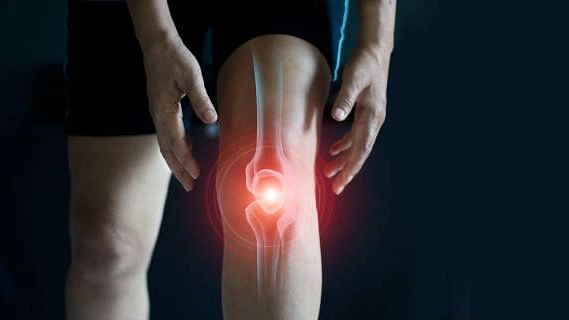
Image for representation.
Credit: iStock Photo
Beijing: Chinese scientists claimed to have developed an advanced lubricating material that could help treat osteoarthritis, a common form of arthritis in the early stages and slow its progression.
A new material developed by the team can “precisely target damaged cartilage areas and provide lubrication protection”, a press release from the Chinese Academy of Sciences (CAS) said last Wednesday.
The product is the result of a study co-led by researchers Li Jiusheng and Lu Hengyi of the CAS Shanghai Advanced Research Institute along with spine surgery and orthopaedics clinician Wang Yunjia at the Xiangya government hospital in Changsha.
Osteoarthritis, the most common form of arthritis, affects the knees, hips, spine and hands. It is a degenerative joint disease in which the affected tissues break down over time causing pain, swelling and stiffness that often reduce mobility.
Reduced lubrication of cartilage – the tissue that covers the ends where two bones meet to form a joint – is thought to be a major factor in triggering osteoarthritis.
Therefore, scientists and clinicians around the world have been searching for biological lubricants that may slow the progression of the disease.
The Chinese team published the results in the peer-reviewed journal Advanced Materials on August 18, the Hong Kong-based South China Morning Post reported on Monday.
The newly developed material consists of “hydrogel microspheres”, tiny, hollow and round particles that are commonly used as injectable biomaterials for the repair of injured tissues, including cartilage, muscle and bone.
These microspheres are made of a biomaterial called gelatin methacrylate – produced from a natural protein derived from collagen – and a well-known polymer composed of very large molecules, called poly (sulfobetaine methacrylate) or PSBMA.
The former allows cells to adhere, proliferate and mature within the constructs, while the latter exerts a strong hydration capacity, according to the study paper prepared by the scientists. To improve the material’s function in treating osteoarthritis, the researchers also developed an antibody that would target injured cartilage sites and anchor it to the microspheres, it said.
An antibody is a large protein used by the immune system to identify and neutralise disease-causing antigens.
The team said that compared to existing bio-lubricants for treating arthritis, which “lack precise targeting for small inflammatory lesions”, the treatment they have discovered can more precisely target damaged tissue.
When injected into rats with early osteoarthritis, the new biomaterial significantly slowed disease progression and reduced symptoms, according to the study paper.
This is particularly meaningful for this condition because the damage to the soft tissues in the joint is chronic and widely recognised as irreversible, so early protection can prevent more damaging wear and tear.
The material also performed well in terms of lubrication. It reduced the average coefficient of friction – or the ratio of the force of friction between two bodies – by more than half compared to standard saline infusions shown to have therapeutic effect for osteoarthritis sufferers.
Compared to conventional bio-lubricants, the average friction coefficient was lowered by more than a third.
The discovery represents “a promising, convenient technique for treating osteoarthritis, particularly for slowing the early-stage osteoarthritis progression”, the paper said.
According to the latest available figures from the World Health Organisation, (WHO) about 528 million people worldwide were living with osteoarthritis in 2019, an increase of 113 per cent since 1990.
Many factors can contribute to the development of the disease, including a history of joint injury or overuse, as well as ageing and being overweight.
According to the WHO, with ageing populations and increasing rates of obesity and injury, the prevalence of osteoarthritis is expected to continue to rise worldwide.